Natalie Wood
Natalie Wood (born Natalia Nikolaevna Zakharenko; July 20, 1938 – November 29, 1981) was an American actress who began her career in film as a child actor and successfully transitioned to young adult roles. She was the recipient of four Golden Globes, and received three Academy Award nominations.
Natalie Wood | |
|---|---|
 Wood in 1973 | |
| Born | Natalia Nikolaevna Zakharenko (Наталья Николаевна Захаренко) July 20, 1938 San Francisco, California, U.S. |
| Died | November 29, 1981 (aged 43) |
| Cause of death | Probable drowning and other undetermined factors[1] |
| Resting place | Westwood Village Memorial Park Cemetery |
| Other names | Natasha Gurdin |
| Occupation | Actress |
| Years active | 1943–1981 |
| Spouse(s) | |
| Children | 2, including Natasha Gregson Wagner |
| Relatives | Lana Wood (sister) Katie Wagner (stepdaughter) |
Wood began her acting career at age 4 and was given a co-starring role at age 8 in Miracle on 34th Street (1947).[2] As a teenager, she earned a nomination for the Academy Award for Best Supporting Actress for her performance in Rebel Without a Cause (1955), followed by a role in John Ford's The Searchers (1956). Wood starred in the musical films West Side Story (1961) and Gypsy (1962), and she received nominations for the Academy Award for Best Actress for her performances in Splendor in the Grass (1961) and Love with the Proper Stranger (1963). Her career continued with films such as Sex and the Single Girl (1964), Inside Daisy Clover (1964), and Bob & Carol & Ted & Alice (1969).
During the 1970s, Wood began a hiatus from film and had a child with husband Robert Wagner, whom she had previously married and divorced. Wagner and Wood remarried after she divorced her second husband. She acted in only two feature films throughout the decade, but appeared slightly more often in television productions, including a remake of the film From Here to Eternity (1979) for which she received a Golden Globe Award. Wood's films represented a "coming of age" for her and for Hollywood films in general.[3] Critics have suggested that her cinematic career represents a portrait of modern American womanhood in transition, as she was one of the few to take both child roles and those of middle-aged characters.[4][5]
Wood drowned off Catalina Island on November 29, 1981, at age 43. The events surrounding her death have been explained by conflicting witness statements,[6] prompting the Los Angeles County Sheriff's Department, under the instruction of the coroner's office, to list her cause of death as "drowning and other undetermined factors" in 2012.[7] In 2018, Wagner was named as a person of interest in the ongoing investigation into her death.[8]
Early life
Natalie Wood was born Natalia Nikolaevna Zakharenko[9][10][11] in San Francisco, California, the daughter of Russian immigrant parents Nikolai Stepanovich Zakharenko (1912–1980) and Maria Stepanovna Zakharenko (née Zudilova; 1908–1998). Natalia's father was born in Vladivostok into the poor family of Stepan Zakharenko, a chocolate-factory worker who joined the anti-Bolshevik civilian forces during the Russian Civil War.[12] Her grandfather was killed in 1918 in a street fight between Red and White Russian soldiers.[13] After that, his wife and her three sons fled to their relatives in Montreal, Quebec, Canada. Later, they moved to San Francisco, where Nikolai worked as a day laborer and carpenter.[14][15]
Natalia's mother, Maria, was born in Barnaul.[16] Maria’s father, Stepan Zudilov, owned soap and candle factories, as well as an estate outside the city.[12] With the start of the civil war, his family left Russia, resettling as refugees in the Chinese city of Harbin.[17] Maria married Alexander Tatuloff in China and had a daughter, Olga (1928–2015).[18] Natalia liked to describe her family as having been either gypsies or landowning aristocrats in Russia.[19] In her youth, her mother had dreamed of becoming an actress or ballet dancer. Natalia and her sisters were raised Russian Orthodox. As an adult, she stated, "I'm very Russian, you know."[20] She spoke both English and Russian with an American accent.[21]
Biographer Warren Harris wrote that under the family's "needy circumstances", Wood's mother may have transferred her ambitions to her middle daughter. Her mother would take little Natalia to the movies as often as she could: "Natalie's only professional training was watching Hollywood child stars from her mother's lap," notes Harris.[22] Wood would later recall this time, "My mother used to tell me that the cameraman who pointed his lens out at the audience at the end of the Paramount newsreel was taking my picture. I'd pose and smile like he was going to make me famous or something. I believed everything my mother told me."[22]
Shortly after Natalia was born in San Francisco, her family moved to Santa Rosa. Natalia (often called "Natasha", the Russian diminutive)[23] was noticed by members of a crew during a film shoot in downtown Santa Rosa. Her mother soon moved the family to Los Angeles in order to pursue a film career for her daughter. After Natalia started acting as a child, David Lewis and William Goetz, studio executives at RKO Radio Pictures, changed her name to Natalie Wood,[24] in reference to director Sam Wood.[25]
Wood's younger sister, Svetlana Gurdin (the family had changed their surname), was born in Santa Monica after the move. Now known as Lana Wood, she also became an actress.
Career
Child actress
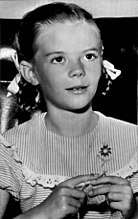
A few weeks before her fifth birthday, Wood made her film debut as a character actress in a fifteen-second scene in the film Happy Land (1943). Despite the brief part, she attracted the notice of the director, Irving Pichel.[26] He remained in contact with Wood's family for two years, advising them when another role came up. The director telephoned Wood's mother and asked her to bring her daughter to Los Angeles for a screen test. Wood's mother became so excited that she "packed the whole family off to Los Angeles to live," writes Harris. Wood's father opposed the idea, but his wife's "overpowering ambition to make Natalie a star" took priority.[27] According to Wood's younger sister Lana, Pichel "discovered her and wanted to adopt her."[28]
Wood, then seven years old, got the part. She played a post-World War II German orphan, opposite Orson Welles as Wood's guardian and Claudette Colbert, in Tomorrow Is Forever (1946). When Wood was unable to cry on cue, her mother tore a butterfly to pieces in front of her to ensure she would sob for a scene.[29] Welles later said that Wood was a born professional, "so good, she was terrifying."[30] After Wood acted in another film directed by Pichel, her mother signed her with 20th Century Fox for her first major role in Miracle on 34th Street (1947), starring Maureen O'Hara, which has become a Christmas classic. Wood was counted among the top child stars in Hollywood after the film and was so popular that Macy's invited her to appear in the store's annual Thanksgiving Day parade.[27]
Film historian John C. Tibbetts wrote that for the next few years following her success in Miracle, Wood played roles as a daughter in a series of family films: Fred MacMurray's daughter in Father Was a Fullback (1949) and Dear Brat (1951); Margaret Sullavan's daughter in No Sad Songs for Me (1950); the youngest sister in Our Very Own (1950 film); James Stewart's daughter in The Jackpot (1950); Joan Blondell's neglected daughter in The Blue Veil (1951); and the daughter of Bette Davis' character in The Star (1952).[3] In all, Wood appeared in over twenty films as a child.
Because Wood was a minor during her early years as an actress, she received her primary education on the studio lots wherever she was contracted. California law required that until age 18, child actors had to spend at least three hours per day in the classroom, notes Harris. "She was a straight A student", and one of the few child actors to excel at arithmetic. Director Joseph L. Mankiewicz, who directed her in The Ghost and Mrs. Muir (1947), said that, "In all my years in the business, I never met a smarter moppet."[27] Wood remembered that period in her life, saying, "I always felt guilty when I knew the crew was sitting around waiting for me to finish my three hours. As soon as the teacher let us go, I ran to the set as fast as I could."[27]
Wood's mother continued to play a significant role in her daughter's early career, coaching her and micromanaging aspects of her career even after Wood acquired agents.[31] As a child actress, Wood received significant media attention. By age nine, she had been named the "most exciting juvenile motion picture star of the year" by Parents magazine.[32]
Teen stardom
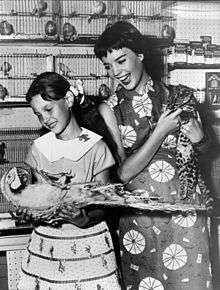
In the 1953–54 television season, Wood played Ann Morrison, the teenage daughter in The Pride of the Family, an ABC situation comedy. She successfully made the transition from child star to ingénue at age 16 when she co-starred with James Dean and Sal Mineo in Rebel Without a Cause (1955), Nicholas Ray's film about teenage rebellion. Wood was nominated for an Academy Award for Best Supporting Actress. She followed this with a small but crucial role in John Ford's The Searchers (1956).
Wood graduated from Van Nuys High School in 1956.[33] She signed with Warner Brothers and was kept busy during the remainder of the decade in many "girlfriend" roles, which she found unsatisfying.[34] The studio cast her in two films opposite Tab Hunter, hoping to turn the duo into a box-office draw that never materialized. Among the other films made at this time were Kings Go Forth and Marjorie Morningstar (both 1958). As Marjorie Morningstar, Wood played the role of a young Jewish girl in New York City who has to deal with the social and religious expectations of her family as she tries to forge her own path and separate identity.
Adult career

Tibbetts observed that Wood's characters in Rebel, Searchers, and Morningstar began to show her widening range of acting styles.[3] Her former "childlike sweetness" was now being combined with a noticeable "restlessness that was characteristic of the youth of the 1950s." After Wood appeared in the box office flop All the Fine Young Cannibals (1960), she lost momentum. Wood's career was in a transition period, having until then consisted of roles as a child or as a teenager.[3]
Splendor in the Grass
Biographer Suzanne Finstad wrote that a "turning point" in Wood's life as an actress took place when she saw the film A Streetcar Named Desire (1951): "She was transformed, in awe of director Elia Kazan and of Vivien Leigh's performance ... [who] became a role model for Natalie."[35] "Her roles raised the possibility that one's sensitivity could mark a person as a kind of victim," noted Tibbetts.[3]
After a "series of bad films, her career was already in decline", according to author Douglas Rathgeb.[36] She was then cast in Kazan's Splendor in the Grass (1961) with Warren Beatty. Kazan wrote in his 1997 memoir that the "sages" of the film community declared her "washed up" as an actress, but he still wanted to interview her for his next film:
When I saw her, I detected behind the well-mannered 'young wife' front a desperate twinkle in her eyes ... I talked with her more quietly then and more personally. I wanted to find out what human material was there, what her inner life was ... Then she told me she was being psychoanalyzed. That did it. Poor R.J. [Wagner], I said to myself. I liked Bob Wagner, I still do.[37]
Kazan cast Wood as the female lead in Splendor, and her career rebounded. He felt that despite her earlier innocent roles, she had the talent and maturity to go beyond them. In the film, Beatty's character was deprived of sexual love with Wood's character, and as a result turns to another, "looser" girl. Wood's character could not handle the sexuality and after a breakdown was committed to a mental institution. Kazan writes that he cast her in the role partly because he saw in Wood's personality a "true-blue quality with a wanton side that is held down by social pressure," adding that "she clings to things with her eyes," a quality he found especially "appealing."[3]
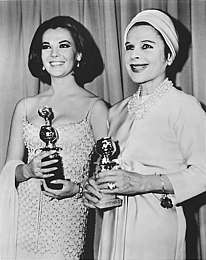
Finstad felt that although Wood had never trained in method acting techniques, "working with Kazan brought her to the greatest emotional heights of her career. The experience was exhilarating, but wrenching for Natalie, who faced her demons on Splendor."[38] She adds that a scene in the film, as a result of "Kazan's wizardry ... produced a hysteria in Natalie that may be her most powerful moment as an actress."[39] Actor Gary Lockwood, who also performed in the film, felt that "Kazan and Natalie were a terrific marriage, because you had this beautiful girl, and you had somebody that could get things out of her." Kazan's favorite scene in the film was the last one, when Wood goes back to see her lost first love, Bud (Beatty). "It's terribly touching to me. I still like it when I see it," wrote Kazan.[40]
For her performance in Splendor, Wood received nominations for the Academy Award, Golden Globe Award, and BAFTA Award for Best Actress in a Leading Role.
West Side Story
Wood played Maria, a restless Puerto Rican girl on the West Side of Manhattan, in West Side Story, Jerome Robbins and Robert Wise's 1961 film of the stage musical, which was a critical and box-office success. Tibbetts wrote of similarities in her role in this film and the earlier Rebel. She was to represent the "restlessness of American youth in the 1950s", expressed by youth gangs and juvenile delinquency, along with early rock and roll. Both films, he observes, were "modern allegories based on the 'Romeo and Juliet' theme, including private restlessness and public alienation. Where in Rebel she falls in love with the character played by James Dean, whose gang-like peers and violent temper alienated him from his family, in West Side Story she enters into a romance with a white former gang member whose threatening world of outcasts also alienated him from lawful behavior."[3]
Although Wood's singing in the film was voiced by Marni Nixon,[41] West Side Story is still regarded as one of Wood's best films. Wood sang when she starred in the film Gypsy (1962).[42] Her appearance in that film led critic Pauline Kael to comment "clever little Natalie Wood ... [the] most machine-tooled of Hollywood ingénues."[3] Wood co-starred in the slapstick comedy The Great Race (1965) with Jack Lemmon, Tony Curtis, and Peter Falk. In the film, her ability to speak Russian was an asset given to her character Maggie DuBois, justifying the character's recording the progress of the race across Siberia and entering the race at the beginning as a contestant. In 1964, at the age of 25, Wood received her third Academy Award nomination for Love with the Proper Stranger (1963), making Wood (along with Teresa Wright) the youngest person to score three Oscar nominations. This record was later broken by Jennifer Lawrence in 2013 and Saoirse Ronan in 2017, both of whom scored their third nominations at the age of 23.
Mid-1960s to 1970
Director Sydney Pollack was quoted as saying about Wood, "When she was right for the part, there was no one better. She was a damn good actress." For Inside Daisy Clover (1965) and This Property Is Condemned (1966), both of which co-starred Robert Redford, Wood received Golden Globe nominations for Best Actress. After the release of the films, Wood suffered emotionally and sought professional therapy.[43] She paid Warner Bros. $175,000 to cancel her contract and fired her entire support team: agents, managers, publicist, accountant, and attorneys.[43]
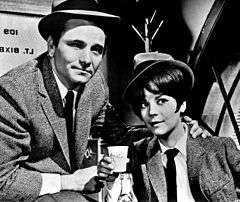
Although many of Wood's films were commercially successful, at times her acting was criticized. In 1966, Wood was given the Harvard Lampoon award for being the "Worst Actress of Last Year, This Year, and Next".[44] She was the first performer to attend their ceremony and accept an award in person. The Harvard Crimson wrote she was "quite a good sport".[45] Following a disappointing reception to Penelope (1966), Wood took a three-year hiatus from acting.[46]
Wood co-starred with Dyan Cannon, Robert Culp and Elliott Gould in Bob & Carol & Ted & Alice (1969), a comedy about sexual liberation. According to Tibbetts, this was the first film in which "the saving leavening of humor was brought to bear upon the many painful dilemmas portrayed in her adult films."[3]
After becoming pregnant in 1970 with her first child, Natasha Gregson, Wood went into semi-retirement. She acted in only four more theatrical films during the remainder of her life. She made a brief cameo appearance as herself in The Candidate (1972), working once more with Robert Redford.

Later career
Wood reunited on the screen with Robert Wagner in the television movie of the week The Affair (1973), and with Laurence Olivier and Wagner in an adaptation of Cat on a Hot Tin Roof (1976) for the British series Laurence Olivier Presents broadcast as a special by NBC. She made cameo appearances on Wagner's prime-time detective series Switch in 1978 as "Bubble Bath Girl," and Hart to Hart in 1979 as "Movie Star".
Returning to feature films after a six-year absence, Wood starred in the comedy crime caper Peeper (1975) opposite former real-life beau Michael Caine. After another lengthy break, she appeared in the ensemble disaster film Meteor (1979) with Sean Connery and the sex comedy The Last Married Couple in America (1980) with George Segal. Her performance in the latter was praised and considered reminiscent of her performance in Bob & Carol & Ted & Alice. In Last Married Couple, Wood broke ground: although an actress with a clean, middle-class image, she used the "F" word in a frank marital discussion with her husband (George Segal).
In this period, Wood had more success in television, receiving high ratings and critical acclaim in 1979 for The Cracker Factory and especially the miniseries film From Here to Eternity (1979), with Kim Basinger and William Devane. Wood's performance in the latter won her a Golden Globe Award for Best Actress in 1980. She starred in The Memory of Eva Ryker, released in May 1980, which proved to be her last completed production.
At the time of her death, Wood was filming the science fiction film Brainstorm (1983), co-starring Christopher Walken and directed by Douglas Trumbull. She was scheduled to make her stage debut on February 12, 1982 in Anastasia at Ahmanson Theatre with Wendy Hiller.[47] Wood had also purchased film rights to the Barbara Wersba book, Country of the Heart, and was planning to star with Timothy Hutton in the drama about the professional-romantic relationship between a tough-minded poet and her much younger student.[48] (The material was eventually adapted into a 1990 TV movie starring Jane Seymour.) She expected to follow her performance as "Anastasia" on the stage with a starring stint in a movie adaptation of the work.[48] The ending of Brainstorm had to be re-written and Wood's character written out of at least three scenes, while a stand-in and sound-alikes were used to replace Wood for some of her crucial shots. The film was released posthumously on September 30, 1983, and was dedicated to Wood in the closing credits.
Wood appeared in 56 films for cinema and television. In one of her last interviews before her death, she was defined as "our sexual conscience on the silver screen."[49] Following her death, Time magazine noted that although critical praise for Wood had been sparse throughout her career, "she always had work".[50]
Personal life
In September 1956, Wood had a brief—and by all accounts unconsummated—relationship with Elvis Presley.[51][52] Her two marriages to actor Robert Wagner were highly publicized.[53] They first married on December 28, 1957 in Scottsdale, Arizona. On June 20, 1961, the couple announced their separation in a joint press release, and divorced ten months later on April 27, 1962.[54]
Following this starter marriage, Wood dated Warren Beatty, Michael Caine and David Niven Jr.. She also had a broken engagement in 1965 with shoe manufacturer Ladislav Blatnik.
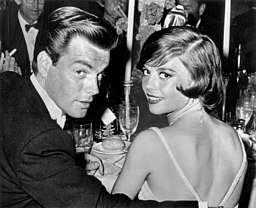
On May 30, 1969, Wood married British producer Richard Gregson after dating for nearly three years. They had a daughter, Natasha (born 1970). Wood filed for divorce from Gregson on August 4, 1971 and it was finalized on April 12, 1972.[55]
After a short-lived romance with future California governor Jerry Brown, Wood resumed her relationship with Wagner at the end of January 1972.[56] They remarried on July 16 aboard the Ramblin' Rose, anchored off Paradise Cove in Malibu. Their daughter Courtney was born in 1974. Wood's sister Lana Wood recalls this period:
Her marriage was considered to be one of the best in Hollywood, and there is no question that she was a devoted, loving—even adoring—mother and stepmother. She and R. J. had begun with love and built from there. They had overcome each other's problems and had reached an accommodation with time and the changes time brings. As with anybody else who has settled into making a long marriage work, they were far more determined than most people to make it work.[57]
Wood and Wagner remained married until her death on November 29, 1981, at age 43. In 2013, retired FBI agent Donald Wilson claimed publicly that he and Wood had a four-year affair from 1973 to 1977 while she was married to Wagner.[58][59] Wilson has discussed his alleged affair with Wood on social media, in tabloid articles and in an on-camera interview for the cable network Reelz.
Suzanne Finstad's 2001 biography of Wood alleges that she was raped by a powerful actor when she was 16.[60][61] Through the recollection of Wood's close friends, which included late actors Scott Marlowe and Dennis Hopper, Finstad summarizes:
Though her five close friends' memories of some details or timing differ after forty-five years, the essence of what each recalls Natalie confiding to them is the same: that the same married film star lured or tricked Natalie, raped her so brutally she was physically injured, and she was too frightened or intimidated to report it to the police. Natalie "hated" her former screen idol afterward, "shuddering" if she heard his name. She would keep the horrible secret, and behave as if nothing happened whenever their paths intersected, too schooled by Mud [her mother] in the politics of Hollywood to cross a powerful movie star.[62]
In 2018, Lana Wood said during a 12-part podcast about her sister's life that the attack had occurred inside the Chateau Marmont during an audition and went on "for hours".[63] According to professor Cynthia Lucia, who studied the attack, Wood's rape was quite brutal and violent.[64]
Death
Wood died at age 43 during the making of Brainstorm while on a weekend boat trip to Catalina Island on board Wagner's yacht Splendour. Outside of drowning, many of the circumstances are unknown; it was never determined how she entered the water. Wood was with her husband Robert Wagner, Brainstorm co-star Christopher Walken, and Splendour's captain Dennis Davern on the evening of November 28, 1981. Authorities recovered her body at 8 a.m. on November 29 one mile away from the boat, with a small Valiant-brand inflatable dinghy beached nearby. Wagner said that she was not with him when he went to bed.[65] The autopsy report revealed that she had bruises on her body and arms, as well as an abrasion on her left cheek, but no indication as to how or when the injuries occurred.[1]
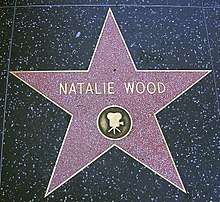
Davern had previously stated that Wood and Wagner argued that evening, which Wagner denied at the time. In his memoir Pieces of My Heart, Wagner admitted that he had an argument with Wood before she disappeared.[1] The autopsy found that Wood's blood alcohol content was 0.14% and that there were traces of a motion-sickness pill and a painkiller in her bloodstream, both of which increase the effects of alcohol.[66] Los Angeles County coroner Thomas Noguchi ruled the cause of her death to be accidental drowning and hypothermia.[67] According to Noguchi, Wood had been drinking and she may have slipped while trying to re-board the dinghy.[1][68] Her sister Lana expressed doubts, alleging that Wood could not swim and had been "terrified" of water all her life, and that she would never have left the yacht on her own by dinghy.[69] Two witnesses who were on a nearby boat stated that they had heard a woman scream for help during the night.[70]
Wood was buried in Westwood Village Memorial Park Cemetery in Los Angeles. Representatives of international media, photographers, and members of the public tried to attend her funeral, but all were required to remain outside the cemetery walls. Among the celebrities were Frank Sinatra, Elizabeth Taylor, Fred Astaire, Rock Hudson, David Niven, Gregory Peck, Gene Kelly, Elia Kazan, and Laurence Olivier.[71] Olivier flew in from London in order to attend the service.[72]

The case was reopened in November 2011 after Davern publicly stated that he had lied to police during the initial investigation and that Wood and Wagner had an argument that evening. He alleged that Wood had been flirting with Walken, that Wagner was jealous and enraged, and that Wagner had prevented Davern from turning on the search lights and notifying authorities after Wood's disappearance. Davern alleged that Wagner was responsible for her death.[1][73][74][75] Walken hired a lawyer, co-operated with the investigation, and was not considered a suspect by authorities.[76]
In 2012, Los Angeles County Chief Coroner Lakshmanan Sathyavagiswaran amended Wood's death certificate and changed the cause of death from accidental drowning to "drowning and other undetermined factors".[77] The amended document included a statement that it is "not clearly established" how Wood ended up in the water. Detectives instructed the coroner's office not to discuss or comment on the case.[77] On January 14, 2013, the Los Angeles County coroner's office offered a 10-page addendum to Wood's autopsy report. The addendum stated that Wood might have sustained some of the bruises on her body before she went into the water, but that this could not be definitively determined.[78] Forensic pathologist Michael Hunter speculated that Wood was particularly susceptible to bruising because she had taken the drug Synthroid.[79]
In February 2018, Wagner was named a person of interest in the investigation; he has denied any involvement.[80][81][82] In a 2018 report, the Los Angeles Times cited the coroner's report from 2013 saying that Wood had unexplained fresh bruising on her right forearm, left wrist, and right knee, a scratch on her neck and a superficial scrape on her forehead. Officials said that it is possible that she was assaulted before she drowned.[83]
For its last 20 years, Splendour, the 55-foot yacht on which Wood had been aboard on the night of her death, had been in the Ala Wai Small Boat Harbor near Waikiki in Honolulu, Hawaii, but was in extremely poor condition.[84] Its owner had accrued $12,000 in fees for its illegal mooring between June 2019 and January 2020.[84] On January 27, 2020, JS International Inc. removed the vessel from the harbor, then dismantled and demolished it after they salvaged what they could.[84]
TV film portrayal
The 2004 TV film The Mystery of Natalie Wood chronicles Wood's life and career. It was partly based on the biographies Natasha: the Biography of Natalie Wood by Suzanne Finstad and Natalie & R.J. by Warren G. Harris.[85] Justine Waddell portrays Wood.[86][87]
Filmography
Accolades
See also
References
- "Natalie Wood's death certificate amended". BBC News. August 22, 2012. Retrieved August 22, 2012.
- Wilkins, Barbara (December 13, 1976). "Second Time's the Charm – Marriage, Natalie Wood, Robert Wagner". People. 6 (24). Retrieved March 11, 2010.
- Tibbetts, John C.; Welsh, James M., eds. (2010). American Classic Screen Profiles. Scarecrow Press. pp. 146–149. ISBN 978-0-8108-7676-7.
- Lucia, Cynthia (2015). 'Natalie Wood, Studio Stardom and Hollywood in Transition.' in American film history : selected readings. Lucia, Cynthia A., Grundmann, Roy, Simon, Art. Chicester, West Sussex. pp. 423–447. ISBN 978-1118475133. OCLC 908086219.
- Sullivan, Rebecca (2016). Natalie Wood. British Film Institute. London. ISBN 978-1844576371. OCLC 933420525.
- Kashner, Sam. "Natalie Wood's Death, Still Shrouded in Mystery – and the Clues That Remain". Vanities. Retrieved January 13, 2018.
- "Natalie Wood's death certificate changed to reflect new uncertainty". The Guardian. Associated Press. August 22, 2012. Retrieved August 3, 2019.
- Salam, Maya (February 3, 2018). "New Doubts in Natalie Wood's Death: 'I Don't Think She Got in the Water by Herself'". The New York Times.
- Lambert 2004, p. 18.
- Truex, Leslie (2012). Natalie Wood: A Biography. ISBN 978-1614646648. Retrieved February 6, 2017.
- "'Natasha' – The Natalie Wood Story". CBS News. August 1, 2001. Retrieved February 6, 2017.
- "Natalie Wood's Russian roots".
- Lambert 2004, p. 8.
- Lambert 2004, pp. 8–9.
- Harris 1988, p. 20.
- Lambert 2004, p. 4.
- Lambert 2004, p. 7.
- "Olga Viripaeff's Obituary". San Francisco Chronicle. Retrieved January 24, 2016.
- Lambert 2004, pp. 4, 7.
- Lambert 2004, p. 3.
- Lambert 2004, pp. 26, 272.
- Harris 1988, p. 21.
- Lambert 2004, p. 19.
- Lambert 2004, p. 30.
- Wood, Lana (1984). Natalie: A Memoir by Her Sister. London: Columbus Books. p. 8.
- Lambert 2004, pp. 25–26.
- Harris 1988, p. 25.
- Wood 1984, p. 50.
- Moore, Paul (July 8, 2001). "Natalie Wood's life of beauty, agony". The Baltimore Sun. Retrieved July 5, 2019.
- John J. O'Connor (July 8, 1988). "TV Weekend; A Documentary Remembrance of Natalie Wood". The New York Times. Retrieved September 19, 2012.
- Rubin, Merle (July 30, 2001). "The Story of Natalie Wood Is Also the Story of Her Mother". Los Angeles Times. Retrieved July 5, 2019.
- Lambert 2004, p. 37.
- Lambert 2004, p. 102.
- Lambert 2004, p. 115.
- Finstad 2001, p. 107.
- Rathgeb, Douglas L. (2004). The Making of Rebel Without a Cause. Jefferson, North Carolina: McFarland & Company. p. 199. ISBN 0-7864-6115-2. Retrieved March 12, 2014.
- Kazan 1997, p. 602.
- Finstad 2001, p. 259.
- Finstad 2001, p. 260.
- Finstad 2001, p. 263.
- Lambert 2004, p. 171.
- Lambert 2004, p. 185.
- Finstad 2001.
- "Bonhams : A pair of Natalie Wood awards from The Harvard Lampoon and The Harvard Crimson". www.bonhams.com. Retrieved May 3, 2019.
- Alexander, Jeffrey C. (April 18, 1966). "Lampoon Fixes Date With Natalie; Wood Will Win 'Worst' on Saturday". The Harvard Crimson.
- "Penelope (1966)". Turner Classic Movies. Retrieved May 3, 2019.
- Lambert 2004, p. 301.
- Rex Reed (December 2, 1981). "A star that left the firmament too soon". New York Daily News.
- "Natalie Wood: Our Sexual Conscience on the Silver Screen". L'Officiel/USA. August 1980. pp. 87–88.
- "The Last Hours of Natalie Wood". Time. December 14, 1981. (subscription required)
- Harris, Warren G. (2011). Natalie and R.J.: The Star-Crossed Love Affair of Natalie Wood and Robert Wagner. Graymalkin Media. p. 1912. ISBN 978-1935169864.
- Mason, Bobbie Ann (2007). Elvis Presley: A Life. Penguin. p. 70. ISBN 978-1101201381.
- "Gale". galeapps.galegroup.com. Retrieved March 12, 2019.
- Lambert 2004, p. 176.
- "Natalie Wood: A Hollywood enigma". BBC News. November 18, 2011.
- Lambert 2004, p. 257.
- Wood, Lana. ch. 40
- "NATALIE WOOD'S SECRET FBI LOVE AFFAIR". December 2, 2013. Retrieved June 1, 2020.
- "MURDER MYSTERY? Natalie Wood: Secret Affair With FBI Agent and His Claim That Her Death Was NOT an Accident". June 5, 2017. Retrieved June 1, 2020.
- "Natalie Wood 'raped as a teenager'". BBC News. August 1, 2001. Retrieved April 8, 2019.
- Collins, Nancy (December 19, 2011). "The Real Tragedy of Natalie Wood". Newsweek. Retrieved April 8, 2019.
- Finstad 2001, p. 174.
- Nolasco, Stephanie (July 31, 2018). "Natalie Wood's sister Lana claims star was raped, reveals details of her sibling's final days". Fox News. Retrieved April 8, 2019.
- Chan, Anna (July 26, 2018). "Lana Wood: Natalie Wood was sexually assaulted as a teen". AOL. Us Magazine. Retrieved July 19, 2019.
- Winton, Richard (July 9, 2012). "Natalie Wood death probe yields more unanswered questions". Los Angeles Times. Retrieved June 15, 2016.
- Finstad 2001, p. 433.
- Noguchi & DiMona 1983, p. 43.
- "What Really Happened the Night Natalie Wood Died". Huffington Post. November 18, 2015. Retrieved January 27, 2017.
- "Natalie Wood was too 'terrified' of water to try to leave Robert Wagner on yacht by dinghy". November 19, 2011. Retrieved February 2, 2018.
- "How The Times covered Natalie Wood's mysterious death in 1981". Retrieved February 2, 2018.
- Lambert 2004, pp. 320–321.
- Harris 1988, p. 210.
- "Captain: Wagner responsible for Natalie Wood death". Today.com. November 18, 2011. Retrieved May 23, 2014.
- "Boat captain alleges actor Robert Wagner responsible for Natalie Wood's death". Today.com. Retrieved February 2, 2018.
- "Natalie Wood Death: New Audio Recordings Indicate Robert Wagner's Involvement". The Huffington Post. September 14, 2012. Retrieved September 17, 2012.
- Meena Hart Duerson (July 9, 2012). "Natalie Wood cause of death changed to 'undetermined', deepening mystery". New York Daily News. Retrieved July 15, 2012.
- McCartney, Anthony (August 21, 2012). "Authorities amend Natalie Wood's death certificate". Associated Press. Retrieved August 22, 2012.
- "Coroner Releases New Report on Natalie Wood Death". Associated Press. Archived from the original on January 17, 2013. Retrieved January 14, 2013.
- "Autopsy: The Last Hours of Natalie Wood." Autopsy: The Last Hours of.... Nar. Eric Meyers. Exec. Prod. Ed Taylor and Michael Kelpie. Reelz, January 30, 2016. Television.
- "Robert Wagner Named Person of Interest in Natalie Wood's Death".
- "Robert Wagner 'Person of interest says investigator". CBS News. February 1, 2018. Retrieved February 1, 2018.
- "Police want to quiz Wagner over Wood death". BBC News. February 6, 2018.
- Chang, Cindy; Lau, Maya (February 2, 2018). "Robert Wagner's action after Natalie Wood's death 'doesn't make any sense,' detective says". Los Angeles Times. Retrieved December 12, 2019.
- Star-Advertiser Staff (January 30, 2020). "Yacht tied to Natalie Wood's drowning removed from harbor". Honolulu Star-Advertiser. Retrieved January 30, 2020.
- Gallo, Phil (February 26, 2004). "The Mystery of Natalie Wood". Variety. Variety Media, LLC. Penske Business Media, LLC. Retrieved March 23, 2018.
- Smith, Austin (February 29, 2004). Lynch, Stephen (ed.). "Lost Star- What Really Happened to Film Goddess Natali Wood". New York Post. Jesse Angelo. ISSN 1090-3321. Retrieved March 23, 2018.
- Stasi, Landi (March 1, 2004). Lynch, Stephen (ed.). "Natalie Goes Overboard – Wood's Death not the Only Mystery". New York Post. Jesse Angelo. ISSN 1090-3321. Retrieved March 23, 2018.
- "Academy Awards Search | Natalie Wood". awardsdatabase.oscars.org. Retrieved February 18, 2020.
- "Natalie Wood". Golden Globes. Retrieved February 18, 2020.
- "Imprint Ceremonies Archive | TCL Chinese Theatres". Retrieved February 18, 2020.
- "BAFTA Awards – 1963 Foreign Actress". Bafta. Retrieved February 18, 2020.
- "Natalie Wood". Walkoffame.com. Retrieved September 15, 2012.
- "Palm Springs Walk of Stars by date dedicated" (PDF). palmspringswalkofstars.com. Archived from the original (PDF) on October 13, 2012. Retrieved September 19, 2012.
Sources
- Finstad, Suzanne (2001). Natasha: The Biography of Natalie Wood. Three Rivers Press. ISBN 978-0-609-80957-0. Retrieved July 24, 2010.
- Frascella, Lawrence; Weisel, Al (2005). Live Fast, Die Young: The Wild Ride of Making Rebel Without a Cause. Touchstone. ISBN 0-7432-6082-1.
- Kazan, Elia (1997). Elia Kazan: A Life. New York: Da Capo Press. p. 602. ISBN 0-306-80804-8.
- Lambert, Gavin (2004). Natalie Wood: A Life. London: Faber and Faber. ISBN 978-0-571-22197-4. Retrieved July 24, 2010.
- Harris, Warren G. (1988). Hollywood's Star-Crossed Lovers "Natalie and R.J.". Doubleday. ISBN 978-0-385-23691-1. Retrieved July 24, 2010.
- Nickens, Christopher. Natalie Wood: A Biography in Photographs. Doubleday, 1986. ISBN 0-385-23307-8.
- Noguchi, Thomas T.; DiMona, Joseph (1983). Coroner. New York: Simon & Schuster. ISBN 0-671-46772-7.
- Rulli, Marti; Davern, Dennis (2009). Goodbye Natalie, Goodbye Splendour. Medallion. ISBN 978-1-59777-639-4.
- Tibbetts, John C.; Welsh, James M., eds. (2010). American Classic Screen Profiles. Scarecrow Press. ISBN 978-0-8108-7676-7.
- Wood, Lana (1984). Natalie: A Memoir by Her Sister. Putnam Pub Group. ISBN 0-399-12903-0. Retrieved March 12, 2014.
External links
| Wikimedia Commons has media related to Natalie Wood. |
- Natalie Wood on IMDb
- Natalie Wood at Who2
- Natalie Wood interview on BBC Radio 4 Desert Island Discs, May 16, 1980
- Interview with Natalie Wood’s daughter, Natasha Gregson Wagner. Accessed November 17, 2016.